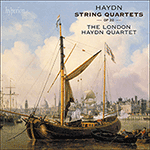
Welcome to Hyperion Records, a British classical label devoted to presenting high-quality recordings of music of all styles and from all periods from the twelfth century to the twenty-first.
Hyperion offers both CDs, and downloads in a number of formats. The site is also available in several languages.
Please use the dropdown buttons to set your preferred options, or use the checkbox to accept the defaults.

| The London Haydn Quartet» More |
The desolate minuet, its unease enhanced by the pervasive five-bar phrases, is relieved by its exquisite, lulling E flat major trio. Both minuet and trio fade away strangely on the brink of C minor, an effect that Haydn replicates in the unsettling pianissimo close of the finale. Though written against the background of sonata form, the Poco adagio, in G major, is essentially a fantasy on a single ardent melody. (A rare surviving sketch for Op 20 reveals that Haydn originally conceived the melody for cello rather than first violin.) Each of its reappearances is characterized by an evocative new sonority, typical of the composer’s heightened sensitivity to tone colour throughout the Op 20 quartets.
from notes by Richard Wigmore © 2011
Le menuet désolé, à l’agitation rehaussée par d’envahissantes phrases de cinq mesures, est apaisé par son trio en mi bémol majeur, exquis et rassurant. Le menuet et le trio s’effacent tous deux étrangement au bord d’ut mineur, un effet que l’on retrouve dans la perturbante conclusion pianissimo du finale. Quoique écrit sur fond de forme sonate, le Poco adagio en sol majeur est avant tout une fantaisie sur une seule et même mélodie ardente (originellement conçue pour le violoncelle et non pour le premier violon, comme le révèle une des rares esquisses survivantes de l’op. 20). Chacune de ses réapparitions se caractérise par une nouvelle sonorité évocatrice, typique de la sensibilité exacerbée du compositeur quant à la couleur sonore de tout son op. 20.
extrait des notes rédigées par Richard Wigmore © 2011
Français: Hypérion
Das trostlose Menuett, in seiner Unruhe durch die beharrlichen Fünftaktphrasen gesteigert, wird durch ein herrliches, besänftigendes Es-Dur-Trio gemildert. Menuett wie auch Trio verklingen seltsamerweise an der Schwelle zu c-Moll—ein Effekt, den Haydn im verstörenden Pianissimo-Schlussteil des Finales aufgreift. Obwohl auf der Sonatenform aufbauend, ist das Poco adagio in G-Dur im Prinzip eine Fantasie über eine einzige, sehnliche Melodie. (Eine seltene erhaltene Skizze zu op. 20 offenbart, dass Haydn diese Melodie ursprünglich für das Cello statt für die erste Geige vorgesehen hatte.) Jede Wiederkehr ist durch ein neues klangliches Kolorit gekennzeichnet, was für die durchweg gesteigerte Sensibilität des Komponisten für Klangfarben in den Quartetten von op. 20 typisch ist.
aus dem Begleittext von Richard Wigmore © 2011
Deutsch: Arne Muus
 Haydn: String Quartets Op 20 Haydn: String Quartets Op 20Haydn’s remarkable Opus 20 quartets are rightfully regarded as landmarks in the history of the string quartet. The six works are all individual masterpieces, revealing astonishing consistency and a huge variety of form and style, contrasting dynam ...» More |

